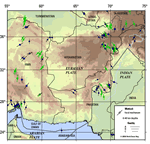
A seismotectonic map shows geologic, seismological, and other information that
is pertinent to seismic hazards but previously was scattered among many
sources. Afghanistan is part of the Eurasian plate. Afghan seismicity
is driven by the relative northward movements of the Arabian plate past
western Afghanistan at 33 mm/yr and of the Indian plate past eastern
Afghanistan at 39 mm/yr or faster as both plates subduct under Eurasia.
Afghanistan is laced with faults. Known faults large enough to have been
mapped at a scale of 1:500,000 are least abundant in the stable North
Afghan platform, more abundant in the accreted terranes of southern Afghanistan,
and most likely to slip rapidly and generate earthquakes in eastern and
southeastern Afghanistan in the broad transpressional plate boundary
with the Indian plate. Crustal earthquakes are most abundant in and around
northeastern Afghanistan as a result of the northward subduction of the
Indian plate. Crustal earthquakes are somewhat less abundant in much
of the transpressional plate boundary with India. Central and western Afghanistan are
least seismically active. Beneath the Hindu Kush of northeastern Afghanistan
and the Pamirs of adjacent Tajikistan, numerous mantle earthquakes occur
within a steeply dipping, northeast-trending, tabular zone that is 700
km long and extends nearly to 300 km depth. Except for the Chaman fault
that forms part of the western edge of the transpressional plate boundary
in Pakistan and Afghanistan, published evidence for or against the activity
of individual Afghan faults is sparse.
Version 1.0
|
| Posted September 2005 |
|
Part or all of this report is presented in Portable Document Format. The latest
version of Adobe Acrobat Reader or similar software is required
to view it. If you wish to download the latest version of Acrobat
Reader free of charge, click here.
|
|

